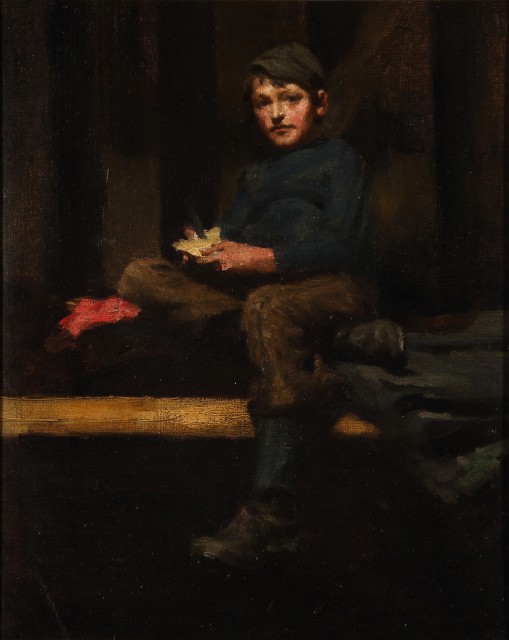LOST HENRY SCOTT TUKE PORTRAIT
AMBROSE ROUFFIGNAC IN NEWLYN
LOST PORTRAIT REDISCOVERED
In the autumn of 1883, Tuke was just 25 years old, a young artist from Falmouth keen to see Newlyn where so many of his fellow artists were finding their inspiration. He had been studying in Paris but was brought back to Cornwall by the early death of his brother. Now that he was back in Cornwall he wanted to meet up with Stanhope Forbes, Walter Langley, William John Wainwright, Edwin Harris and the rest .He was particularly friendly with Thomas Cooper Gotch and his wife Caroline.
He stayed there for three months painting various scenes in the Newlyn School manner.
He found lodgings in Trewarveneth Street, in the heart of the picturesque fishing port, in a house belonging to Philip Harvey who was a sail maker. The house had a sail loft, used to store sails and other equipment. It was a shadowy, atmospheric place. There was a long bench and Tuke noticed interesting effects in the light that shone through a window to the left - it would be a perfect background for a painting.
Ambrose Charles Rouffignac was a 13 year old lad from a nearby house who used to appear in the sail loft, probably earning money by helping out. He would make a good model for a picture.
Ambrose was persuaded to sit on the bench, in an entirely natural pose of a boy eating a working person’s picnic dinner. He holds a knife and some food.
Tuke enjoyed conversations with Ambrose-he was fascinated by the boy’s accent-and the boy must have found Tuke intriguing also. Ambrose could talk about his sister Mary and his brothers William and Francis. His father, like most men in Newlyn, was a fisherman. No doubt Tuke heard how his mother had died the previous May. Tuke could see the potential in the boy; he told a friend: “If you got so grand to keep a tiger (groom) he would do very well, he is very paintable and has a nice Cornish accent.” Tuke painted a sensitive portrait of the boy, who sits unselfconsciously on a bench surrounded by sails and ropes. His food has been wrapped in a bright red cloth, whose bright colour catches the attention like a flame in the shadowy dimness of the scene. The light from the left illuminates the boy’s face.
Tuke painted another woek, Dinner Time, using the same scene, but in the latter work the boy is at the right hand of the canvas and an equal area to the left shows the bundled sails and equipment.
The artist left Newlyn that November to live and work in Falmouth and became increasingly known for his portraits of male figures and boating subjects.
Ambrose developed his capability with sails and boats, becoming a master mariner. In 1895 he married a Newlyn girl called Caroline Bodinnar Trahair.The wedding was in Cardiff. They moved up the hill from Trewarveneth Street to ‘Carn Dhu’ in the village of Paul. They had 5 children.
By the outbreak of the First World War Ambrose Charles Rouffignac was a captain in the Merchant Navy. In August 1916 he was captain of the SS Antelope. While in the Mediterranean, en route from Marseilles, the ship was stopped by an Austrian submarine. All the crew- which included his own son- were allowed to take to the lifeboats before the ship was sunk by gunfire.
The following year on May 28th 1917, he was on the SS Antinoe, a defensively armed merchant ship of 2,396 tons. They were 150 miles west of Bishop Rock when the ship was torpedoed without warning and sunk. Twenty-one lives were lost, including Ambrose Rouffignac himself.
His name is listed on Tower Hill Memorial, London, on a headstone in Paul Cemetery and in the Penzance Book of Remembrance. Perhaps the his most enduring monument is this sensitive portrait of a rather cheeky boy eating his dinner in a sale loft, totally at home amidst the equipment which is to shape his future, looking up for a moment with the steady, cheerful confidence which will make him a captain of ships.
Ambrose Charles Rouffignac 1870 – 1917.
